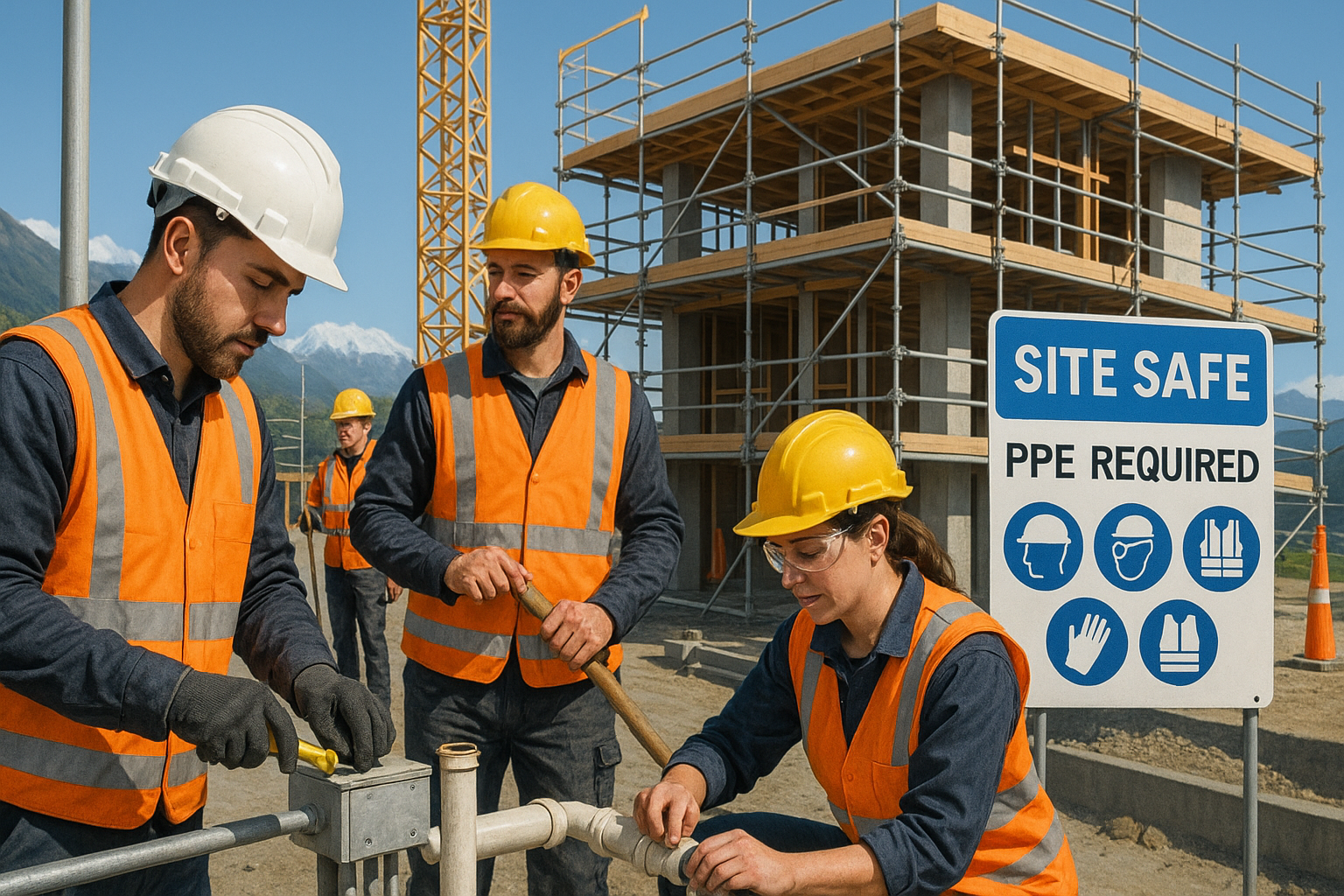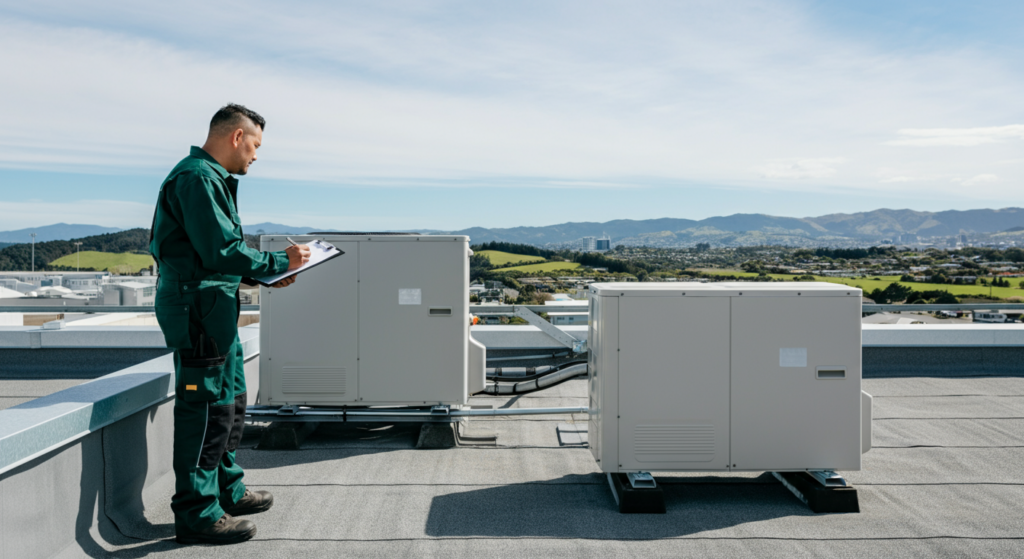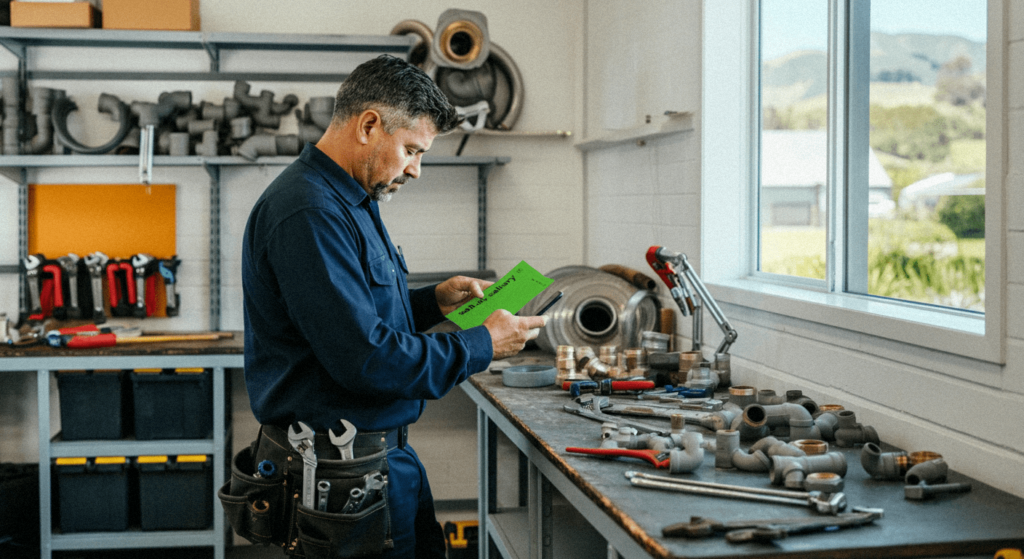New Zealand relies on the hard work and expertise of its tradespeople in carpentry, air conditioning, electrical work, and plumbing etc to keep the country running smoothly. However, these important industries can also create some real and important health and safety problems for workers. It is not only important for to keep everyone safe, but also the right thing to do. It’s something we have to do to follow the law and help make the business work well. If you’re in the trades, knowing what responsibilities you have and putting efficient safety measures in place is necessary. WHS stands for a set of rules and procedures that make sure all workers, people visiting, or working at the job site are protected and kept safe and healthy.
The guide looks into the key parts of WHS in the trade industry in the New Zealand trades industry, explaining WHS meaning, outlining legal obligations, common risks, and practical strategies to create a safer working environment.
Workplace Health and Safety- WHS meaning
WHS in New Zealand aims to prevent injuries and illnesses by handling risks that may come from work activities. In the construction, electrical, plumbing, carpentry, and similar specialist trades, WHS manages the risks involved in falls, electrical safety, demolition work, dealing with noise, and machinery use.
The law reaches most places of work and employer-employee relations, and it stresses that safety is everyone’s responsibility, not something that can be given over to others through contracts.
WHS and OHS: In New Zealand, WHS (Workplace Health and Safety) and OHS (Occupational Health and Safety) are essentially interchangeable terms, and it is referring to the same concept: ensuring the safety and well-being of workers and others in the workplace.
The Foundation: Understanding the Health and Safety at Work Act 2015 (HSWA)
The HSWA 2015 is the bedrock of New Zealand’s WHS system. It establishes a framework of duties and responsibilities for all parties involved in a work environment. A key concept introduced by the Act is the Person Conducting a Business or Undertaking (PCBU).
Who is a PCBU?
In the context of the trades, a PCBU is typically the business entity – this could be a company, a partnership, or even a self-employed sole trader. If you run a trades business, you are most likely a PCBU and have the primary duty of care for health and safety.
Primary Duty of a PCBU
The primary duty of a PCBU is to ensure, so far as is reasonably practicable, the health and safety of:
- Workers who work for the PCBU while they are at work.
- Workers whose activities are influenced or directed by the PCBU (e.g., contractors or labour hire workers).
- Other persons (like visitors or the public) who could be put at risk by the work being carried out.
“Reasonably practicable” means what you could reasonably be expected to do in your situation to ensure health and safety, taking into account factors like:
- The likelihood of the hazard or risk occurring.
- The degree of harm that could result.
- What you know, or ought reasonably to know, about the risk and ways to eliminate or minimise it.
- The availability and suitability of ways to eliminate or minimise the risk.
- The cost of eliminating or minimising the risk, in proportion to the risk.
The Role of Officers
The HSWA also requires Officers of a PCBU to take an active role and make sure they do all they can to keep workers safe. An Officer is someone who holds a position that allows them to exercise significant influence over the management of the business (e.g., directors, partners). Officers must do what they can to make sure the PCBU does its part to keep the workplace safe. This includes:
- Acquiring and keeping up-to-date knowledge of WHS matters.
- Gaining an understanding of the hazards and risks associated with the business’s operations.
- Ensuring the business has appropriate resources and processes to eliminate or minimise risks.
- Ensuring appropriate processes are in place to receive, consider, and respond to information about incidents, hazards, and risks.
- Ensuring the business has and implements processes for complying with its duties.
Worker Responsibilities
While PCBUs have the primary duty, workers also have important responsibilities under the HSWA. Workers must:
- Take reasonable care for their own health and safety.
- Take reasonable care that their acts or omissions do not adversely affect the health and safety of other persons.
- Comply, so far as they are reasonably able, with any reasonable instruction given by the PCBU.
- Co-operate with any reasonable policy or procedure relating to health and safety at the workplace.
Consultation and Participation
A crucial element of the HSWA is that PCBUs need to work together and make sure they talk and co-operate with workers and other PCBUs when it comes to health and safety. Workers are often the first to see potential hazards and usually have really good ideas for simple and safe ways to deal with them. It is necessary to interact with workers through health and safety representatives or committees to strengthen the company’s safety culture.
WHS Meaning for Tradies
Work Health and Safety (WHS) is crucial for tradies because their jobs involve high risks of injury and illness, with tradies accounting for a large proportion of workplace accidents and compensation claims. Prioritizing WHS meaning is protecting both physical and mental health, reducing financial and legal risks for workers and employers, and helping maintain productivity and a positive reputation. A strong WHS culture also fosters teamwork and job satisfaction, making worksites safer and more supportive for everyone involved. In short, effective WHS practices are essential for safeguarding tradies and ensuring the long-term success of their businesses.
Common Health and Safety Risks in the New Zealand Trades
The trades industry encompasses a wide range of activities, each with its specific hazards. However, several risks are common across many trades, particularly in construction and related sectors. These include:
- Working at Heights: Falls from roofs, scaffolding, ladders, or elevated work platforms are a leading cause of serious injury and fatalities in the trades. Risks include inadequate fall protection, unstable platforms, poor ladder use, and working on fragile surfaces.
- Moving Objects and Vehicles: Being struck by moving plant (like forklifts, excavators), falling objects, or vehicles on site is a significant risk. Poor site layout, lack of traffic management plans, and inadequate signage contribute to these hazards.
- Manual Handling: Lifting, carrying, pushing, and pulling heavy or awkward loads can lead to musculoskeletal disorders (strains, sprains, back injuries). Poor lifting techniques, lack of mechanical aids, and repetitive tasks increase this risk.
- Hazardous Substances: Exposure to chemicals (solvents, adhesives, paints), dusts (silica, asbestos, wood dust), fumes, and gases can cause immediate or long-term health issues. Risks include inadequate ventilation, lack of personal protective equipment (PPE), and improper handling and storage.
- Plant and Machinery: Operating machinery like saws, grinders, drills, excavators, and cranes poses risks from entanglement, crushing, cuts, and ejection of materials. Hazards include unguarded machinery, lack of training, poor maintenance, and bypassing safety features.
- Electricity: Working with electrical systems or near live power lines carries the risk of electric shock, burns, and electrocution. Risks include unqualified workers, faulty equipment, inadequate isolation procedures, and lack of awareness of buried or overhead cables.
- Noise and Vibration: Prolonged exposure to loud noise from tools and machinery can cause permanent hearing loss. Hand-arm vibration from power tools can lead to debilitating conditions like Hand-Arm Vibration Syndrome (HAVS). Risks include inadequate hearing protection and using vibrating tools for extended periods without breaks.
- Confined Spaces: Working in enclosed or partially enclosed spaces (like trenches, tanks, roof spaces) can expose workers to risks of suffocation, hazardous atmospheres (lack of oxygen, toxic gases), and entrapment. Hazards include lack of ventilation, inadequate testing of the atmosphere, and insufficient rescue plans.
- Psychosocial Risks: Stress, fatigue, bullying, and harassment can also impact worker health and safety. Factors like tight deadlines, long hours, poor communication, and workplace culture contribute to these risks.
Managing Risks: The Essential Process
Effectively managing WHS risks in the trades involves a systematic approach:
- Identify Hazards: Walk through the workplace, observe tasks, talk to workers, and review incident reports to identify anything that could cause harm. Think about the specific risks associated with the trade being performed.
- Assess Risks: Once hazards are identified, assess the likelihood of harm occurring and the potential severity of that harm. This helps prioritise which risks need to be addressed first.
- Control Risks: Implement control measures to eliminate or minimise the risks as far as is reasonably practicable. Use the “hierarchy of controls” to guide your decisions:
- Elimination: Remove the hazard entirely (e.g., design out the need for working at height).
- Substitution: Replace the hazard with a safer alternative (e.g., use a less toxic substance).
- Isolation: Separate people from the hazard (e.g., use barriers or exclusion zones).
- Engineering Controls: Use physical controls to minimise the risk (e.g., machine guards, ventilation systems, scaffolding with edge protection).
- Administrative Controls: Implement procedures, training, and supervision (e.g., safe work procedures, permits to work, limiting exposure time).
- Personal Protective Equipment (PPE): Provide workers with appropriate gear (e.g., helmets, safety glasses, gloves, hearing protection, safety boots, high-visibility clothing). PPE is the least effective control and should only be used when higher-level controls are not sufficient.
- Review Controls: Regularly review the implemented control measures to ensure they are effective and remain appropriate. Workplaces and tasks change, so risk assessments and controls should be living documents.
Practical Steps for Trades Businesses
Implementing effective WHS requires more than just understanding the law; it requires practical action:
- Develop a Health and Safety Policy: A clear policy demonstrates commitment to WHS and outlines expectations.
- Implement a Safety Management System: This provides a structured approach to managing WHS, including procedures for risk assessment, incident reporting, training, and monitoring.
- Provide Inductions and Training: Ensure all workers receive thorough inductions covering site-specific hazards and general WHS procedures. Provide specific training for tasks involving high risks (e.g., working at height, operating machinery).
- Conduct Regular Site Inspections and Toolbox Talks: Regularly inspect workplaces for hazards and hold short, focused safety discussions with the team before starting work or a new task.
- Ensure Availability and Correct Use of PPE: Provide the necessary PPE free of charge and ensure workers are trained on how to use and maintain it correctly.
- Maintain Plant and Equipment: Establish a regular maintenance schedule for all tools and machinery to ensure they are in good working order.
- Have Emergency Procedures: Develop clear procedures for emergencies (fire, medical incident, structural collapse) and ensure workers know what to do. Have adequate first aid facilities and trained first aiders available.
- Investigate Incidents and Near Misses: Thoroughly investigate all incidents and near misses to identify root causes and prevent recurrence.
- Encourage Reporting: Foster a culture where workers feel comfortable reporting hazards, incidents, and near misses without fear of reprisal.
- Monitor Worker Health: Implement health monitoring where required, particularly for exposure to substances like asbestos or excessive noise.
WorkSafe New Zealand: Support and Enforcement
WorkSafe New Zealand is the primary regulator for workplace health and safety in the country. Their role includes:
- Providing guidance and resources to help businesses understand and meet their WHS obligations.
- Conducting inspections and investigations.
- Enforcing compliance with the HSWA, which can include issuing improvement notices, prohibition notices, and potentially leading to prosecution for serious breaches.
WorkSafe’s website is a valuable resource for specific guidance relevant to the trades industry.
The Benefits of Proactive WHS
Investing in WHS is not just a cost; it’s an investment with significant returns:
- Reduced Injuries and Illnesses: The most important benefit is protecting the well-being of your workers.
- Improved Productivity: A safe workplace experiences fewer disruptions due to accidents or illness, leading to increased efficiency.
- Lower Costs: Good WHS reduces costs associated with injuries, including medical expenses, rehabilitation, lost time, and increased ACC levies.
- Enhanced Reputation: A strong safety record builds trust with clients and attracts skilled workers.
- Improved Morale: Workers who feel safe and valued are more likely to be motivated and loyal.
- Legal Compliance: Avoiding breaches of the HSWA prevents potential fines and legal action.
Workplace Health and Safety in the trades industry is something everyone should contribute to in New Zealand. Taking time to understand the rules, taking steps to avoid hazards, and encouraging a safe atmosphere for all via consultation and training helps trade businesses protect their workers. Prioritising WHS protects lives, strengthens businesses, and contributes to a healthier, more productive New Zealand. Health and safety should be an important factor in all work done each day.




